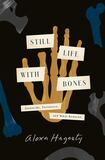
The Independent Commission for the Location of Victims’ Remains, established by the Irish and British governments to try to recover the bodies of 16 people murdered and “disappeared” by the IRA during the 1970s, plans to resume searching in a Monaghan bog this spring for the remains of Columba McVeigh, a Tyrone teenager who is believed to have been abducted and killed by the IRA nearly 50 years ago.
His family’s suffering and quest to recover his body mirrors that of hundreds of thousands of people in Latin America and elsewhere whose relatives were murdered and dumped in mass graves by military dictatorships and whose attempts to locate and exhume their remains are detailed in this powerful and harrowing book.
The fieldwork for the book was done in Guatemala, where state forces killed an estimated 200,000 men, women and children from a population of eight million between 1960 and 1996, and in Argentina, where up to 30,000 people were abducted, tortured, killed and secretly disposed of between 1976 and 1984 by the military junta.
The author, a Stanford University graduate now at Cambridge University in the UK, acknowledges that there is “something intrinsically unsettling” about graduate students from the developed world studying the bodies of genocide victims. But she points out that many countries hold mass graves and that forensic anthropology has two purposes: to obtain evidence of crimes against humanity, and to retrieve the bones of someone who was loved and is mourned, in order to find out how they died and so that they can be given a decent funeral.
Cop30 seeks to tackle the ‘information crisis’ on climate issues
Democratic cave-in to avert US shutdown may lead to a changing of guard within the party
Japan’s death penalty in the spotlight after inmate freed from decades on death row
‘They want to destroy Ukrainian life’: Winter looms over nation’s crippled power grid
The world’s first professional war crimes exhumation team was established by university students in Buenos Aires, Argentina, in 1984, when a fragile democracy replaced the military dictatorship whose victims had become known as “desaparecidos” – literally people who have been disappeared.
The “disappeared” were usually tortured in one of 800 clandestine chambers before being killed. This inflicted another form of torture on their families and friends, who were left helplessly uncertain about their fate and powerless to provide any legal or material help.
“First we will kill all of the subversives, then we will kill all of their collaborators, then those who sympathise with subversives, then we will kill those that remain indifferent, and finally we will kill the timid,” said the governor of Buenos Aires province in May 1976.
Most or all of the 10 women were tortured, drugged and dropped to their deaths into the ocean from Argentine Coast Guard aircraft known as Skyvans, manufactured in Belfast by Short Brothers
Despite this threat, and a junta decree that newspapers could not comment on “subversive incidents” or “the deaths of subversive elements”, a small group of mothers of young adults who had disappeared began to meet each week in public in central Buenos Aires. When these Madres de Plaza de Mayo, who initially numbered only 14, began to attract attention and suffer police harassment, they moved to the ground of the Iglesia Santa Cruz, known locally as “the Irish Church”.
Bodies washed up
That parish’s weekly English language newspaper, the Southern Cross (founded by an Irish priest in 1875 and staffed for decades by Irish exiles) was one of the few to criticise the junta, and the Catholic hierarchy that supported it, and it was from the garden of “the Irish Church” that the leaders of the Mothers of the Disappeared, and two French nuns, were themselves abducted and “disappeared” on December 8th, 1977, the Feast of the Immaculate Conception. Most or all of the 10 women were tortured, drugged and dropped to their deaths into the ocean from Argentine Coast Guard aircraft known as Skyvans, manufactured in Belfast by Short Brothers.
Bodies washed up on Argentina’s Atlantic coast a few weeks later were identified as those of some of the Mothers and the nuns. They were buried in the garden of the Iglesia Santa Cruz – “the last free ground she ever knew”, the daughter of one of the Mothers said.
[ Argentina's shameful World Cup 40 years onOpens in new window ]
In Guatemala, where the reign of State terror began after the US government sponsored the overthrow of a democratically elected president in a coup ostensibly to fight communism and protect the Chiquita banana corporation, the bodies of the “disappeared” were burned, dumped in mass graves or secretly buried in urban cemeteries.
This deeply upsetting book ends with a warning that the terror decades in Guatemala and Argentina happened before dictators had access to mass surveillance
Oral histories of survivors and relatives were gathered while exhumations were under way there. These accounts serve as social history, but also as witness evidence and as therapy. “The world must not forget what happened here,” says one survivor in his “testimonio”.
This deeply upsetting book ends with a warning that the terror decades in Guatemala and Argentina happened before dictators had access to the mass surveillance of facial recognition technology, CCTV or smartphone location.
The title, cover and lack of an index do not do justice to the book. Its multiple horror stories are told with clarity, compassion and utmost respect for the cruelly dead and for those who grieve for them.













